Maternal Health in Australia: Risk Factors and Analysis
VerifiedAdded on 2023/06/11
|12
|1883
|486
AI Summary
This paper analyses the risk factors and trends in maternal health in Australia. It includes exploratory and advanced analysis using R software, and discusses the relationship between health expenditure, number of maternal deaths, and risk of maternal death.
Contribute Materials
Your contribution can guide someone’s learning journey. Share your
documents today.
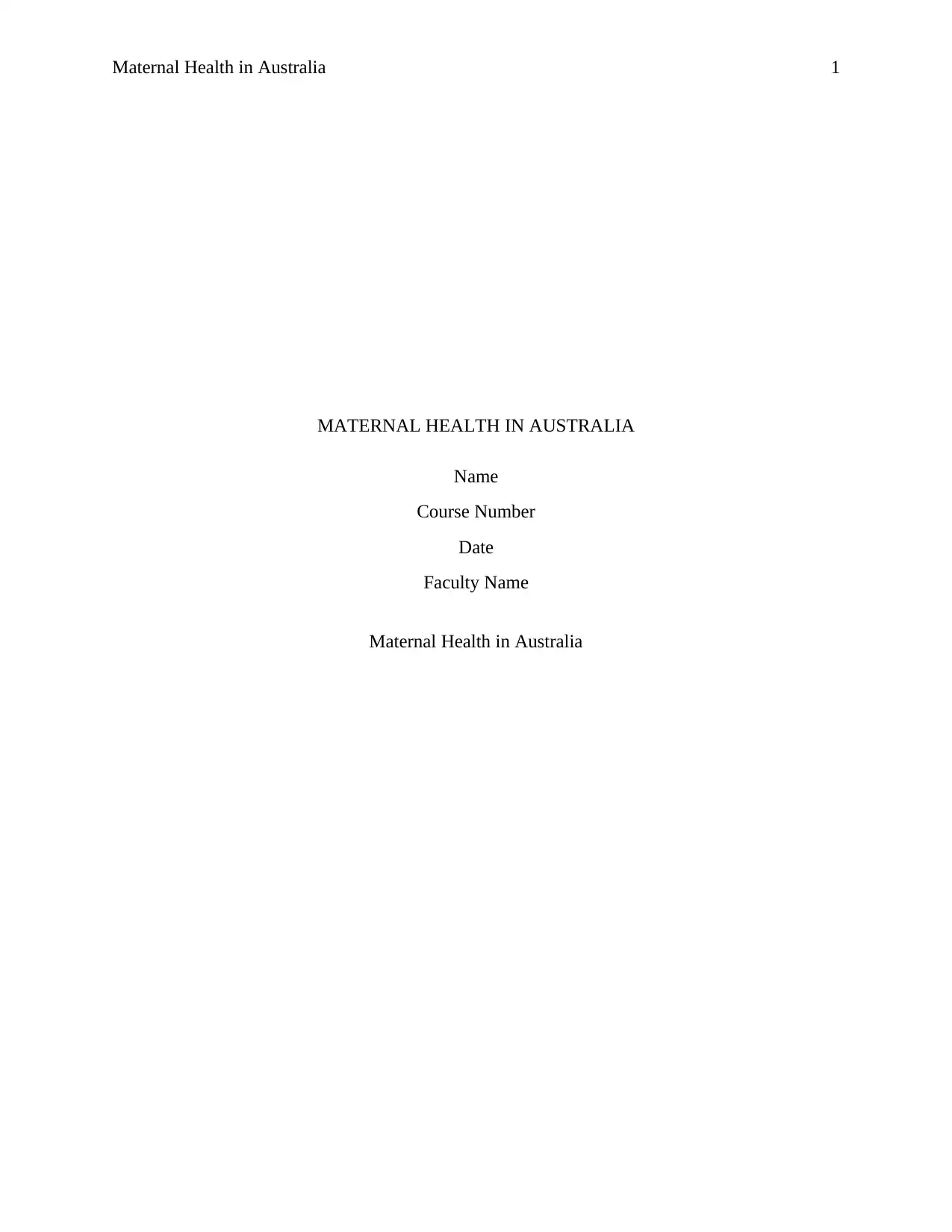
Maternal Health in Australia 1
MATERNAL HEALTH IN AUSTRALIA
Name
Course Number
Date
Faculty Name
Maternal Health in Australia
MATERNAL HEALTH IN AUSTRALIA
Name
Course Number
Date
Faculty Name
Maternal Health in Australia
Secure Best Marks with AI Grader
Need help grading? Try our AI Grader for instant feedback on your assignments.
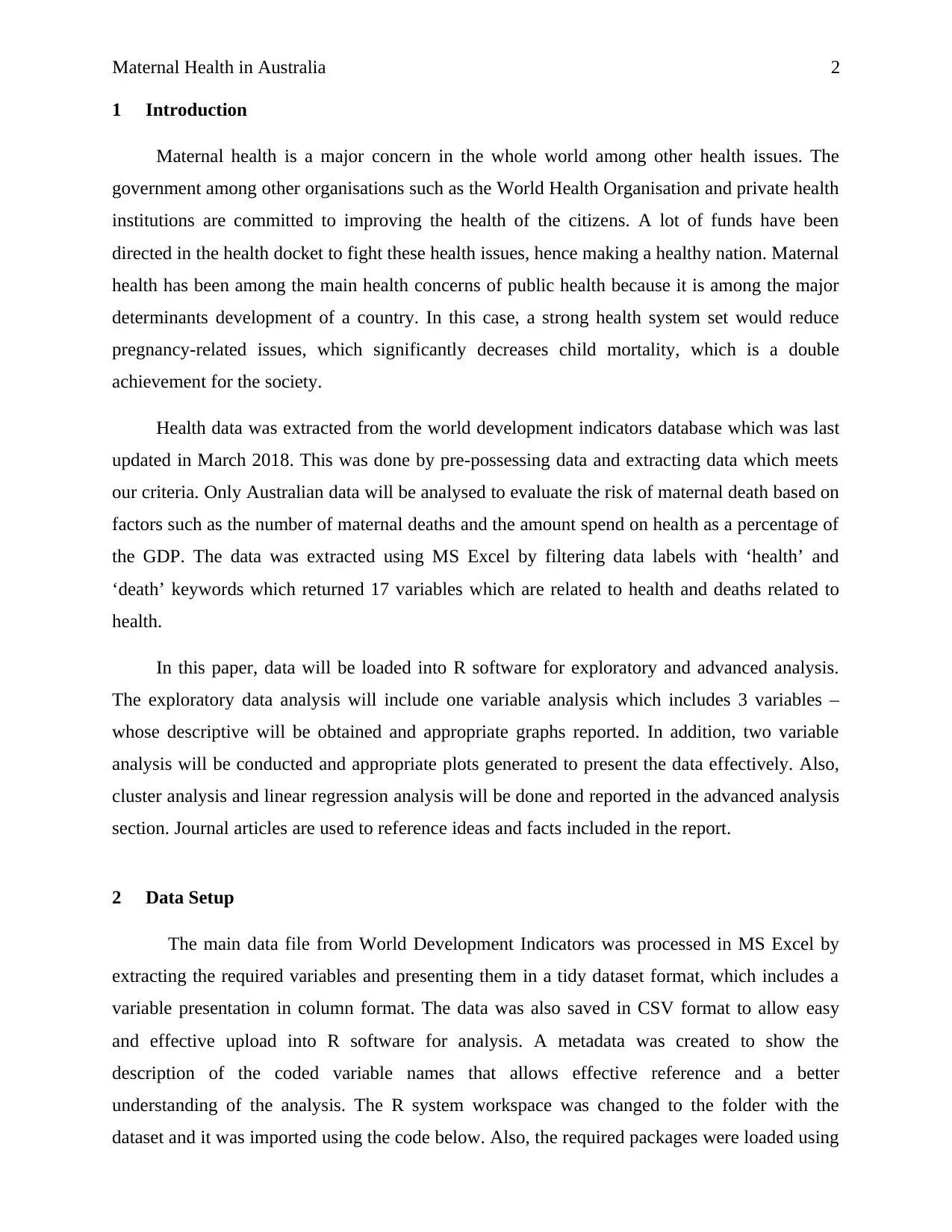
Maternal Health in Australia 2
1 Introduction
Maternal health is a major concern in the whole world among other health issues. The
government among other organisations such as the World Health Organisation and private health
institutions are committed to improving the health of the citizens. A lot of funds have been
directed in the health docket to fight these health issues, hence making a healthy nation. Maternal
health has been among the main health concerns of public health because it is among the major
determinants development of a country. In this case, a strong health system set would reduce
pregnancy-related issues, which significantly decreases child mortality, which is a double
achievement for the society.
Health data was extracted from the world development indicators database which was last
updated in March 2018. This was done by pre-possessing data and extracting data which meets
our criteria. Only Australian data will be analysed to evaluate the risk of maternal death based on
factors such as the number of maternal deaths and the amount spend on health as a percentage of
the GDP. The data was extracted using MS Excel by filtering data labels with ‘health’ and
‘death’ keywords which returned 17 variables which are related to health and deaths related to
health.
In this paper, data will be loaded into R software for exploratory and advanced analysis.
The exploratory data analysis will include one variable analysis which includes 3 variables –
whose descriptive will be obtained and appropriate graphs reported. In addition, two variable
analysis will be conducted and appropriate plots generated to present the data effectively. Also,
cluster analysis and linear regression analysis will be done and reported in the advanced analysis
section. Journal articles are used to reference ideas and facts included in the report.
2 Data Setup
The main data file from World Development Indicators was processed in MS Excel by
extracting the required variables and presenting them in a tidy dataset format, which includes a
variable presentation in column format. The data was also saved in CSV format to allow easy
and effective upload into R software for analysis. A metadata was created to show the
description of the coded variable names that allows effective reference and a better
understanding of the analysis. The R system workspace was changed to the folder with the
dataset and it was imported using the code below. Also, the required packages were loaded using
1 Introduction
Maternal health is a major concern in the whole world among other health issues. The
government among other organisations such as the World Health Organisation and private health
institutions are committed to improving the health of the citizens. A lot of funds have been
directed in the health docket to fight these health issues, hence making a healthy nation. Maternal
health has been among the main health concerns of public health because it is among the major
determinants development of a country. In this case, a strong health system set would reduce
pregnancy-related issues, which significantly decreases child mortality, which is a double
achievement for the society.
Health data was extracted from the world development indicators database which was last
updated in March 2018. This was done by pre-possessing data and extracting data which meets
our criteria. Only Australian data will be analysed to evaluate the risk of maternal death based on
factors such as the number of maternal deaths and the amount spend on health as a percentage of
the GDP. The data was extracted using MS Excel by filtering data labels with ‘health’ and
‘death’ keywords which returned 17 variables which are related to health and deaths related to
health.
In this paper, data will be loaded into R software for exploratory and advanced analysis.
The exploratory data analysis will include one variable analysis which includes 3 variables –
whose descriptive will be obtained and appropriate graphs reported. In addition, two variable
analysis will be conducted and appropriate plots generated to present the data effectively. Also,
cluster analysis and linear regression analysis will be done and reported in the advanced analysis
section. Journal articles are used to reference ideas and facts included in the report.
2 Data Setup
The main data file from World Development Indicators was processed in MS Excel by
extracting the required variables and presenting them in a tidy dataset format, which includes a
variable presentation in column format. The data was also saved in CSV format to allow easy
and effective upload into R software for analysis. A metadata was created to show the
description of the coded variable names that allows effective reference and a better
understanding of the analysis. The R system workspace was changed to the folder with the
dataset and it was imported using the code below. Also, the required packages were loaded using

Maternal Health in Australia 3
the library function. The variables include cluster and fpc which allow cluster analysis and
visualisation. The data characteristics include in this analysis are for Australia only.
setwd("E:/Documents/745360")
mydata <- read.csv("mydata.csv")
library(cluster); library(fpc)
dim(mydata)
3 Exploratory Data Analysis
3.1 One-Variable Analysis
3.1.1 Lifetime Risk of Maternal Death
summary(SH.MMR.RISK.ZS)
## Min. 1st Qu. Median Mean 3rd Qu. Max. NA's
## 0.01152 0.01280 0.01320 0.01358 0.01490 0.01550 1
boxplot(SH.MMR.RISK.ZS,col = 5,
main = "Lifetime Risk of Maternal Death", outline = T, names = T)
the library function. The variables include cluster and fpc which allow cluster analysis and
visualisation. The data characteristics include in this analysis are for Australia only.
setwd("E:/Documents/745360")
mydata <- read.csv("mydata.csv")
library(cluster); library(fpc)
dim(mydata)
3 Exploratory Data Analysis
3.1 One-Variable Analysis
3.1.1 Lifetime Risk of Maternal Death
summary(SH.MMR.RISK.ZS)
## Min. 1st Qu. Median Mean 3rd Qu. Max. NA's
## 0.01152 0.01280 0.01320 0.01358 0.01490 0.01550 1
boxplot(SH.MMR.RISK.ZS,col = 5,
main = "Lifetime Risk of Maternal Death", outline = T, names = T)
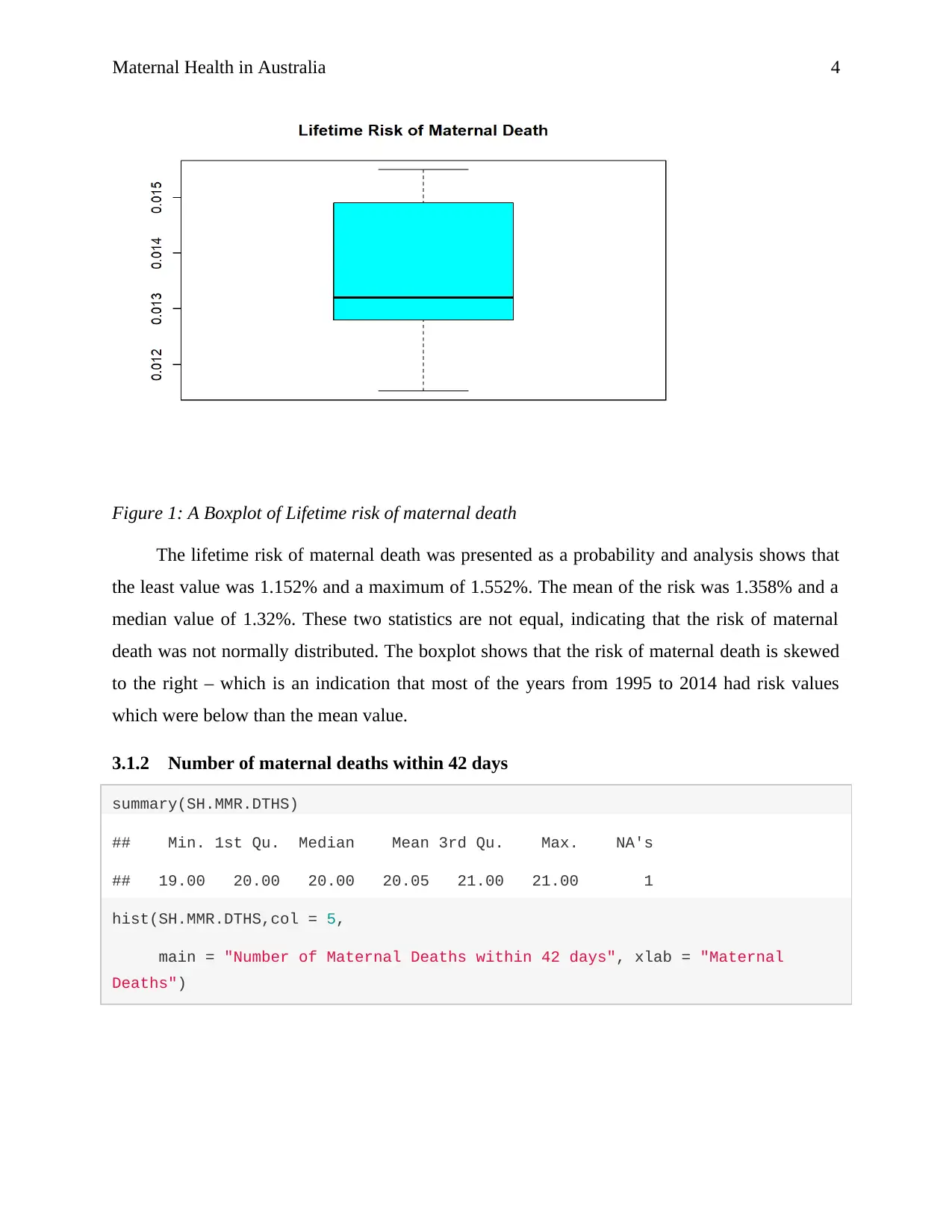
Maternal Health in Australia 4
Figure 1: A Boxplot of Lifetime risk of maternal death
The lifetime risk of maternal death was presented as a probability and analysis shows that
the least value was 1.152% and a maximum of 1.552%. The mean of the risk was 1.358% and a
median value of 1.32%. These two statistics are not equal, indicating that the risk of maternal
death was not normally distributed. The boxplot shows that the risk of maternal death is skewed
to the right – which is an indication that most of the years from 1995 to 2014 had risk values
which were below than the mean value.
3.1.2 Number of maternal deaths within 42 days
summary(SH.MMR.DTHS)
## Min. 1st Qu. Median Mean 3rd Qu. Max. NA's
## 19.00 20.00 20.00 20.05 21.00 21.00 1
hist(SH.MMR.DTHS,col = 5,
main = "Number of Maternal Deaths within 42 days", xlab = "Maternal
Deaths")
Figure 1: A Boxplot of Lifetime risk of maternal death
The lifetime risk of maternal death was presented as a probability and analysis shows that
the least value was 1.152% and a maximum of 1.552%. The mean of the risk was 1.358% and a
median value of 1.32%. These two statistics are not equal, indicating that the risk of maternal
death was not normally distributed. The boxplot shows that the risk of maternal death is skewed
to the right – which is an indication that most of the years from 1995 to 2014 had risk values
which were below than the mean value.
3.1.2 Number of maternal deaths within 42 days
summary(SH.MMR.DTHS)
## Min. 1st Qu. Median Mean 3rd Qu. Max. NA's
## 19.00 20.00 20.00 20.05 21.00 21.00 1
hist(SH.MMR.DTHS,col = 5,
main = "Number of Maternal Deaths within 42 days", xlab = "Maternal
Deaths")
Secure Best Marks with AI Grader
Need help grading? Try our AI Grader for instant feedback on your assignments.

Maternal Health in Australia 5
Figure 2: A histogram of the number of maternal deaths within 42 days
The average number of women who died within 42 days of giving birth of termination of
the pregnancy in any other way was 20 and median of 20.05 which is approximately 21. There is
no great deviation between the mean and the median, hence the conclusion that the number of
women who died due to pregnancy-related issued within 42 days after termination of the
pregnancy was approximately normally distributed – which is depicted in the histogram.
3.1.3 Total Health Expenditure (%GDP)
summary(SH.XPD.TOTL.ZS)
## Min. 1st Qu. Median Mean 3rd Qu. Max. NA's
## 7.260 8.006 8.473 8.443 9.023 9.422 2
boxplot(SH.XPD.TOTL.ZS, outline =T, col = 5,
main = "Total Health Expenditure (% of GDP)")
Figure 2: A histogram of the number of maternal deaths within 42 days
The average number of women who died within 42 days of giving birth of termination of
the pregnancy in any other way was 20 and median of 20.05 which is approximately 21. There is
no great deviation between the mean and the median, hence the conclusion that the number of
women who died due to pregnancy-related issued within 42 days after termination of the
pregnancy was approximately normally distributed – which is depicted in the histogram.
3.1.3 Total Health Expenditure (%GDP)
summary(SH.XPD.TOTL.ZS)
## Min. 1st Qu. Median Mean 3rd Qu. Max. NA's
## 7.260 8.006 8.473 8.443 9.023 9.422 2
boxplot(SH.XPD.TOTL.ZS, outline =T, col = 5,
main = "Total Health Expenditure (% of GDP)")
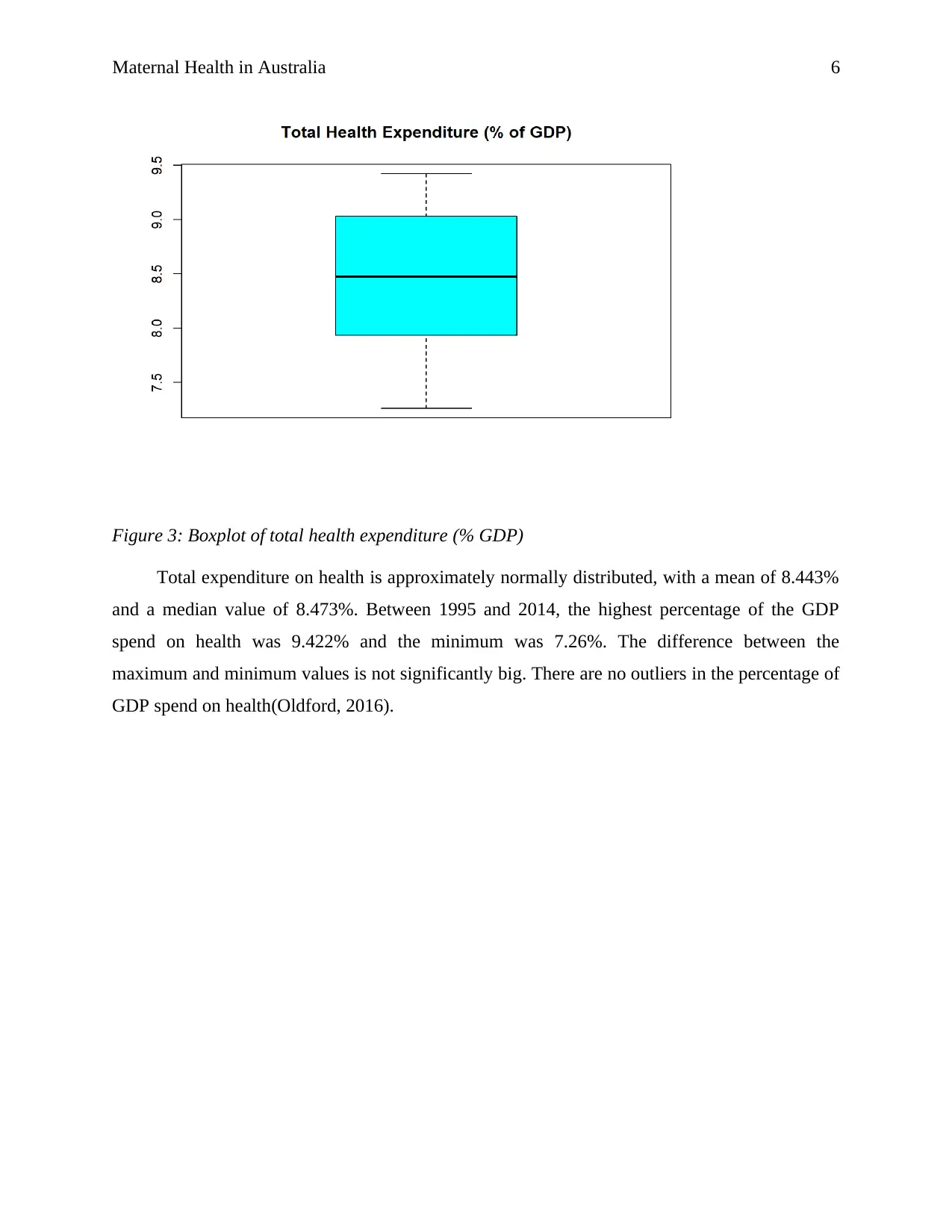
Maternal Health in Australia 6
Figure 3: Boxplot of total health expenditure (% GDP)
Total expenditure on health is approximately normally distributed, with a mean of 8.443%
and a median value of 8.473%. Between 1995 and 2014, the highest percentage of the GDP
spend on health was 9.422% and the minimum was 7.26%. The difference between the
maximum and minimum values is not significantly big. There are no outliers in the percentage of
GDP spend on health(Oldford, 2016).
Figure 3: Boxplot of total health expenditure (% GDP)
Total expenditure on health is approximately normally distributed, with a mean of 8.443%
and a median value of 8.473%. Between 1995 and 2014, the highest percentage of the GDP
spend on health was 9.422% and the minimum was 7.26%. The difference between the
maximum and minimum values is not significantly big. There are no outliers in the percentage of
GDP spend on health(Oldford, 2016).
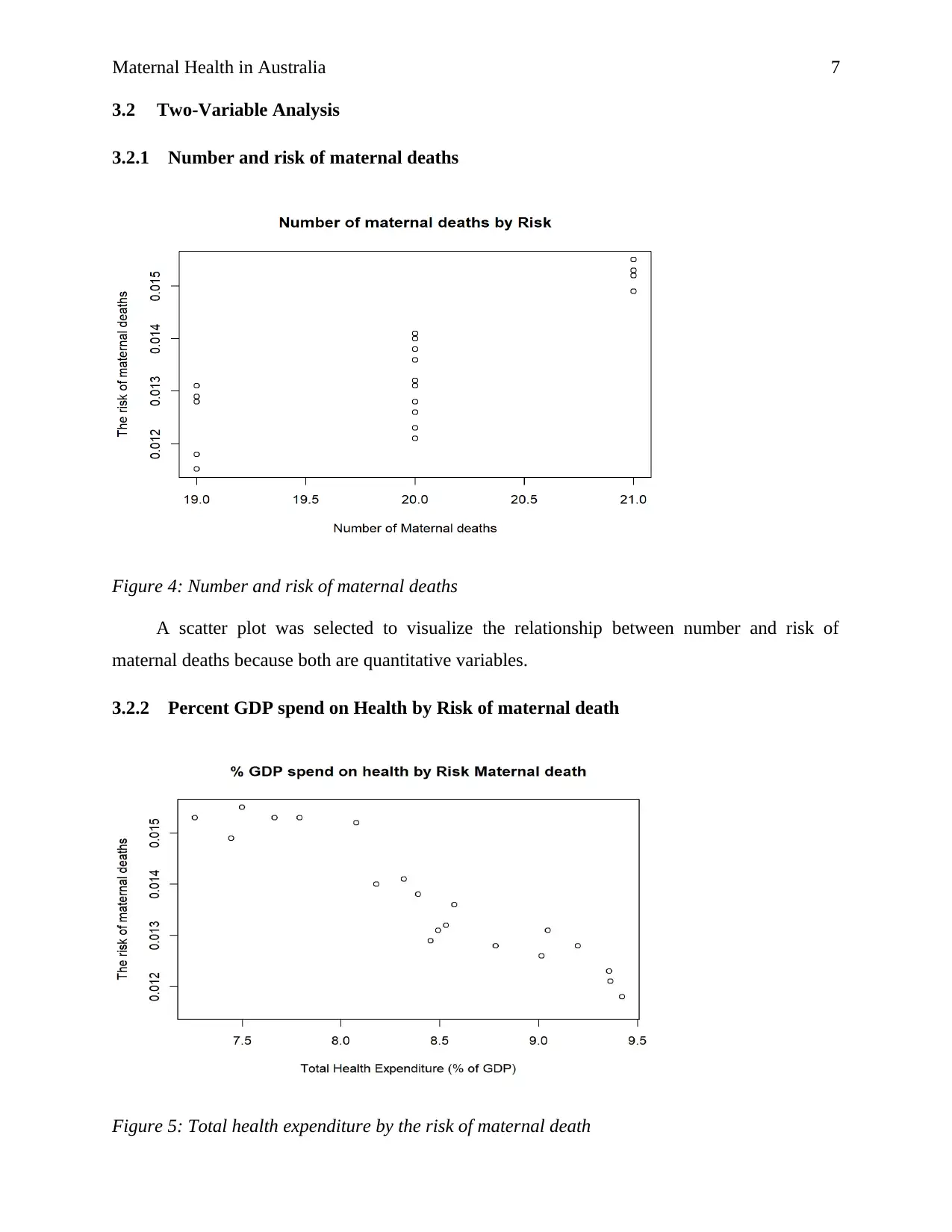
Maternal Health in Australia 7
3.2 Two-Variable Analysis
3.2.1 Number and risk of maternal deaths
Figure 4: Number and risk of maternal deaths
A scatter plot was selected to visualize the relationship between number and risk of
maternal deaths because both are quantitative variables.
3.2.2 Percent GDP spend on Health by Risk of maternal death
Figure 5: Total health expenditure by the risk of maternal death
3.2 Two-Variable Analysis
3.2.1 Number and risk of maternal deaths
Figure 4: Number and risk of maternal deaths
A scatter plot was selected to visualize the relationship between number and risk of
maternal deaths because both are quantitative variables.
3.2.2 Percent GDP spend on Health by Risk of maternal death
Figure 5: Total health expenditure by the risk of maternal death
Paraphrase This Document
Need a fresh take? Get an instant paraphrase of this document with our AI Paraphraser
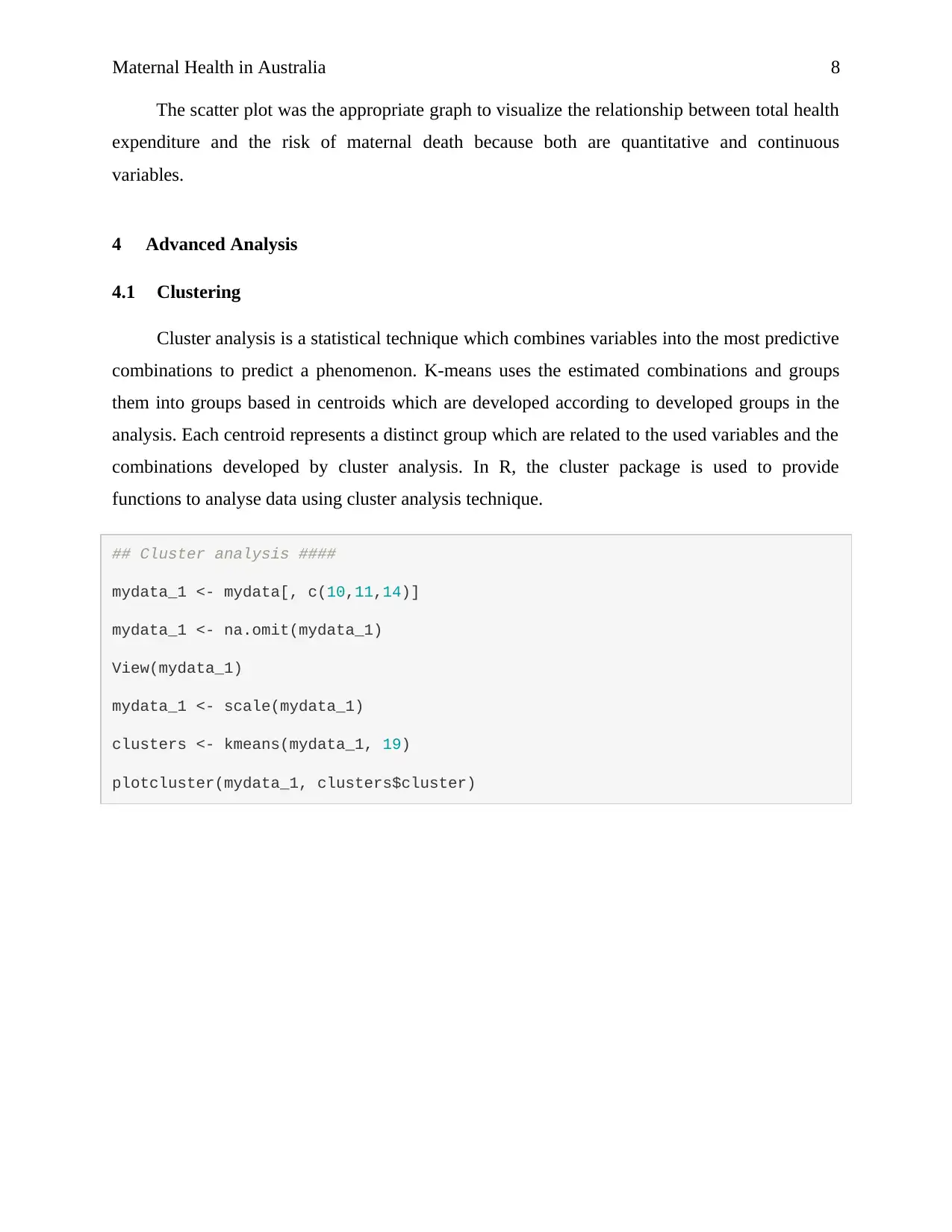
Maternal Health in Australia 8
The scatter plot was the appropriate graph to visualize the relationship between total health
expenditure and the risk of maternal death because both are quantitative and continuous
variables.
4 Advanced Analysis
4.1 Clustering
Cluster analysis is a statistical technique which combines variables into the most predictive
combinations to predict a phenomenon. K-means uses the estimated combinations and groups
them into groups based in centroids which are developed according to developed groups in the
analysis. Each centroid represents a distinct group which are related to the used variables and the
combinations developed by cluster analysis. In R, the cluster package is used to provide
functions to analyse data using cluster analysis technique.
## Cluster analysis ####
mydata_1 <- mydata[, c(10,11,14)]
mydata_1 <- na.omit(mydata_1)
View(mydata_1)
mydata_1 <- scale(mydata_1)
clusters <- kmeans(mydata_1, 19)
plotcluster(mydata_1, clusters$cluster)
The scatter plot was the appropriate graph to visualize the relationship between total health
expenditure and the risk of maternal death because both are quantitative and continuous
variables.
4 Advanced Analysis
4.1 Clustering
Cluster analysis is a statistical technique which combines variables into the most predictive
combinations to predict a phenomenon. K-means uses the estimated combinations and groups
them into groups based in centroids which are developed according to developed groups in the
analysis. Each centroid represents a distinct group which are related to the used variables and the
combinations developed by cluster analysis. In R, the cluster package is used to provide
functions to analyse data using cluster analysis technique.
## Cluster analysis ####
mydata_1 <- mydata[, c(10,11,14)]
mydata_1 <- na.omit(mydata_1)
View(mydata_1)
mydata_1 <- scale(mydata_1)
clusters <- kmeans(mydata_1, 19)
plotcluster(mydata_1, clusters$cluster)

Maternal Health in Australia 9
Figure 6: Cluster plot
The cluster analysis returned 19 clusters showing that each year was independent of each
other(Everitt, Landau, Leese, & Stahl, 2011). Therefore, the variables distinctly represented the
years, hence there was no association between the years. These clusters can be seen in the cluster
plot above.
4.2 Linear Regression
4.2.1 Linear regression 1
fit1 <- lm(SH.MMR.RISK.ZS ~ SH.MMR.DTHS)
summary(fit1)
plot(SH.MMR.DTHS, SH.MMR.RISK.ZS, xlab = "Number of Maternal deaths",
ylab = "The risk of maternal deaths",
main = "Relationship between Number of maternal deaths and Risk")
abline(fit1, col = 2)
Figure 6: Cluster plot
The cluster analysis returned 19 clusters showing that each year was independent of each
other(Everitt, Landau, Leese, & Stahl, 2011). Therefore, the variables distinctly represented the
years, hence there was no association between the years. These clusters can be seen in the cluster
plot above.
4.2 Linear Regression
4.2.1 Linear regression 1
fit1 <- lm(SH.MMR.RISK.ZS ~ SH.MMR.DTHS)
summary(fit1)
plot(SH.MMR.DTHS, SH.MMR.RISK.ZS, xlab = "Number of Maternal deaths",
ylab = "The risk of maternal deaths",
main = "Relationship between Number of maternal deaths and Risk")
abline(fit1, col = 2)
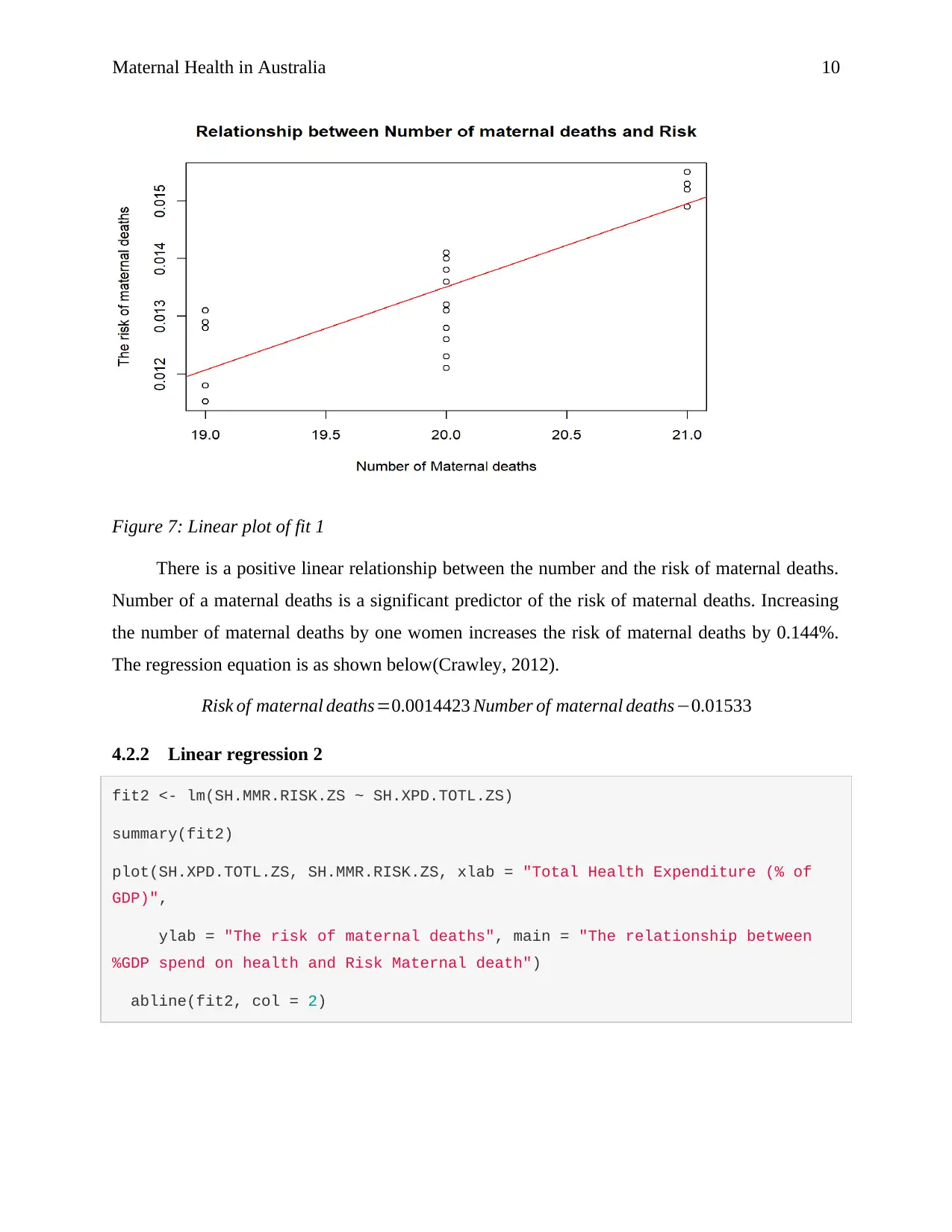
Maternal Health in Australia 10
Figure 7: Linear plot of fit 1
There is a positive linear relationship between the number and the risk of maternal deaths.
Number of a maternal deaths is a significant predictor of the risk of maternal deaths. Increasing
the number of maternal deaths by one women increases the risk of maternal deaths by 0.144%.
The regression equation is as shown below(Crawley, 2012).
Risk of maternal deaths=0.0014423 Number of maternal deaths−0.01533
4.2.2 Linear regression 2
fit2 <- lm(SH.MMR.RISK.ZS ~ SH.XPD.TOTL.ZS)
summary(fit2)
plot(SH.XPD.TOTL.ZS, SH.MMR.RISK.ZS, xlab = "Total Health Expenditure (% of
GDP)",
ylab = "The risk of maternal deaths", main = "The relationship between
%GDP spend on health and Risk Maternal death")
abline(fit2, col = 2)
Figure 7: Linear plot of fit 1
There is a positive linear relationship between the number and the risk of maternal deaths.
Number of a maternal deaths is a significant predictor of the risk of maternal deaths. Increasing
the number of maternal deaths by one women increases the risk of maternal deaths by 0.144%.
The regression equation is as shown below(Crawley, 2012).
Risk of maternal deaths=0.0014423 Number of maternal deaths−0.01533
4.2.2 Linear regression 2
fit2 <- lm(SH.MMR.RISK.ZS ~ SH.XPD.TOTL.ZS)
summary(fit2)
plot(SH.XPD.TOTL.ZS, SH.MMR.RISK.ZS, xlab = "Total Health Expenditure (% of
GDP)",
ylab = "The risk of maternal deaths", main = "The relationship between
%GDP spend on health and Risk Maternal death")
abline(fit2, col = 2)
Secure Best Marks with AI Grader
Need help grading? Try our AI Grader for instant feedback on your assignments.
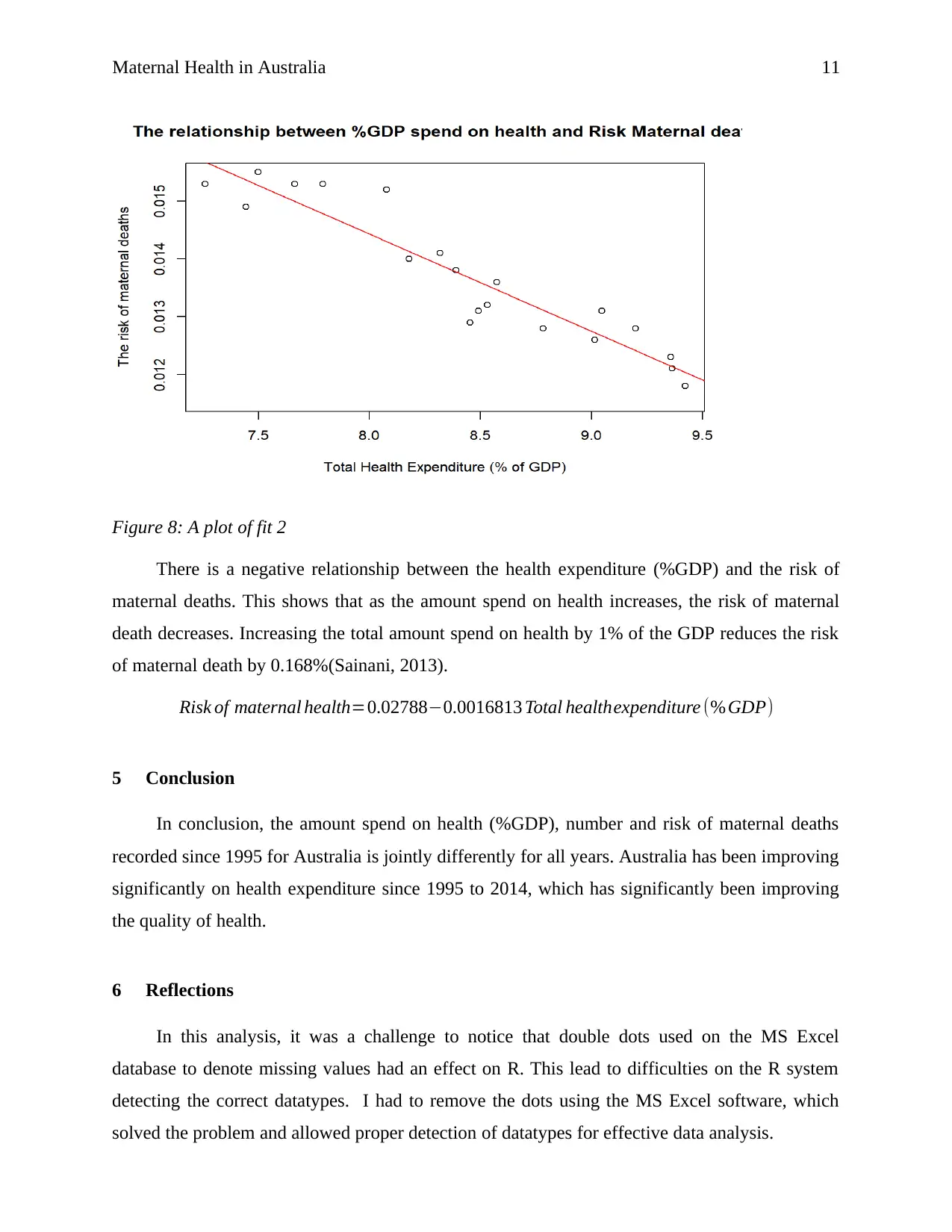
Maternal Health in Australia 11
Figure 8: A plot of fit 2
There is a negative relationship between the health expenditure (%GDP) and the risk of
maternal deaths. This shows that as the amount spend on health increases, the risk of maternal
death decreases. Increasing the total amount spend on health by 1% of the GDP reduces the risk
of maternal death by 0.168%(Sainani, 2013).
Risk of maternal health=0.02788−0.0016813 Total healthexpenditure (% GDP)
5 Conclusion
In conclusion, the amount spend on health (%GDP), number and risk of maternal deaths
recorded since 1995 for Australia is jointly differently for all years. Australia has been improving
significantly on health expenditure since 1995 to 2014, which has significantly been improving
the quality of health.
6 Reflections
In this analysis, it was a challenge to notice that double dots used on the MS Excel
database to denote missing values had an effect on R. This lead to difficulties on the R system
detecting the correct datatypes. I had to remove the dots using the MS Excel software, which
solved the problem and allowed proper detection of datatypes for effective data analysis.
Figure 8: A plot of fit 2
There is a negative relationship between the health expenditure (%GDP) and the risk of
maternal deaths. This shows that as the amount spend on health increases, the risk of maternal
death decreases. Increasing the total amount spend on health by 1% of the GDP reduces the risk
of maternal death by 0.168%(Sainani, 2013).
Risk of maternal health=0.02788−0.0016813 Total healthexpenditure (% GDP)
5 Conclusion
In conclusion, the amount spend on health (%GDP), number and risk of maternal deaths
recorded since 1995 for Australia is jointly differently for all years. Australia has been improving
significantly on health expenditure since 1995 to 2014, which has significantly been improving
the quality of health.
6 Reflections
In this analysis, it was a challenge to notice that double dots used on the MS Excel
database to denote missing values had an effect on R. This lead to difficulties on the R system
detecting the correct datatypes. I had to remove the dots using the MS Excel software, which
solved the problem and allowed proper detection of datatypes for effective data analysis.
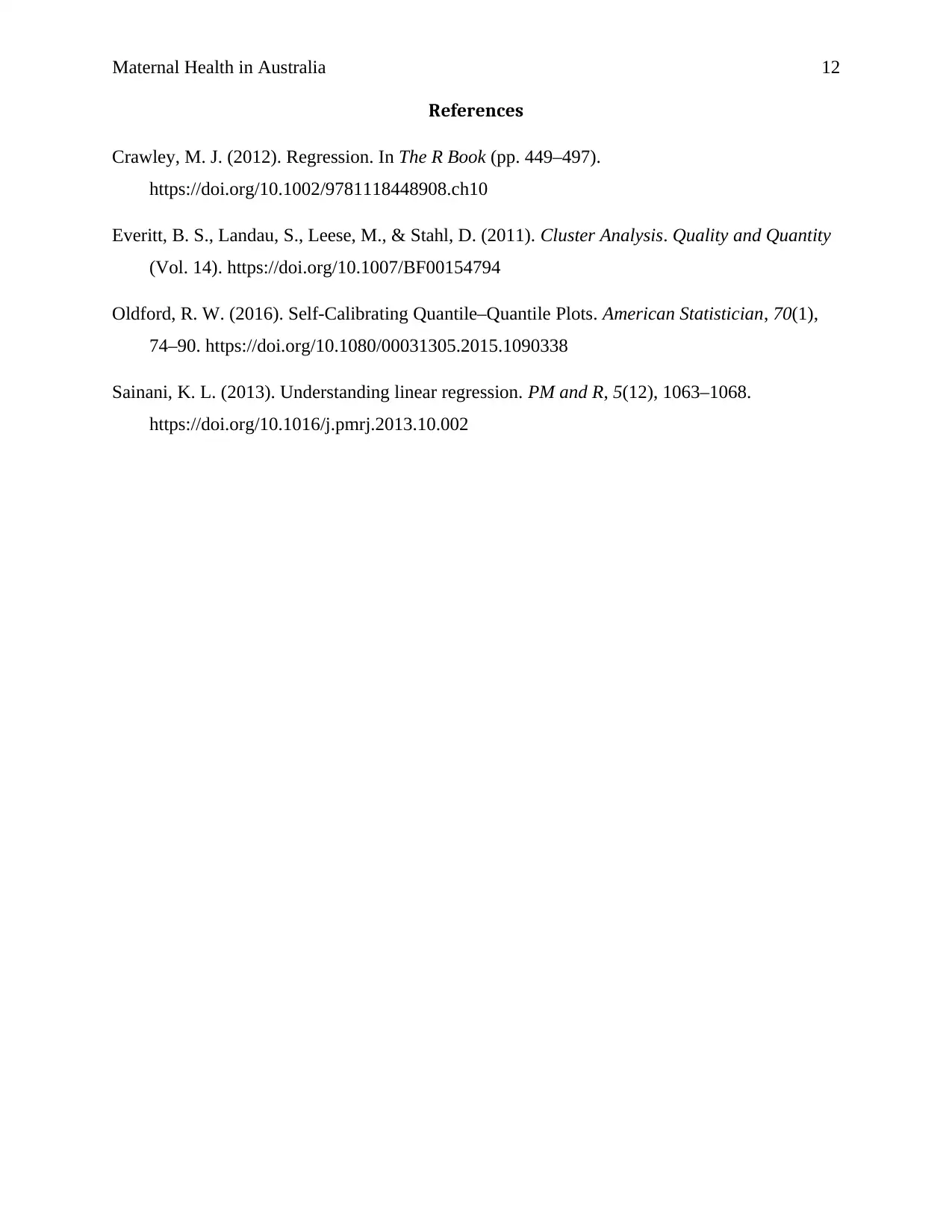
Maternal Health in Australia 12
References
Crawley, M. J. (2012). Regression. In The R Book (pp. 449–497).
https://doi.org/10.1002/9781118448908.ch10
Everitt, B. S., Landau, S., Leese, M., & Stahl, D. (2011). Cluster Analysis. Quality and Quantity
(Vol. 14). https://doi.org/10.1007/BF00154794
Oldford, R. W. (2016). Self-Calibrating Quantile–Quantile Plots. American Statistician, 70(1),
74–90. https://doi.org/10.1080/00031305.2015.1090338
Sainani, K. L. (2013). Understanding linear regression. PM and R, 5(12), 1063–1068.
https://doi.org/10.1016/j.pmrj.2013.10.002
References
Crawley, M. J. (2012). Regression. In The R Book (pp. 449–497).
https://doi.org/10.1002/9781118448908.ch10
Everitt, B. S., Landau, S., Leese, M., & Stahl, D. (2011). Cluster Analysis. Quality and Quantity
(Vol. 14). https://doi.org/10.1007/BF00154794
Oldford, R. W. (2016). Self-Calibrating Quantile–Quantile Plots. American Statistician, 70(1),
74–90. https://doi.org/10.1080/00031305.2015.1090338
Sainani, K. L. (2013). Understanding linear regression. PM and R, 5(12), 1063–1068.
https://doi.org/10.1016/j.pmrj.2013.10.002
1 out of 12
Related Documents
Your All-in-One AI-Powered Toolkit for Academic Success.
+13062052269
info@desklib.com
Available 24*7 on WhatsApp / Email
![[object Object]](/_next/static/media/star-bottom.7253800d.svg)
Unlock your academic potential
© 2024 | Zucol Services PVT LTD | All rights reserved.





